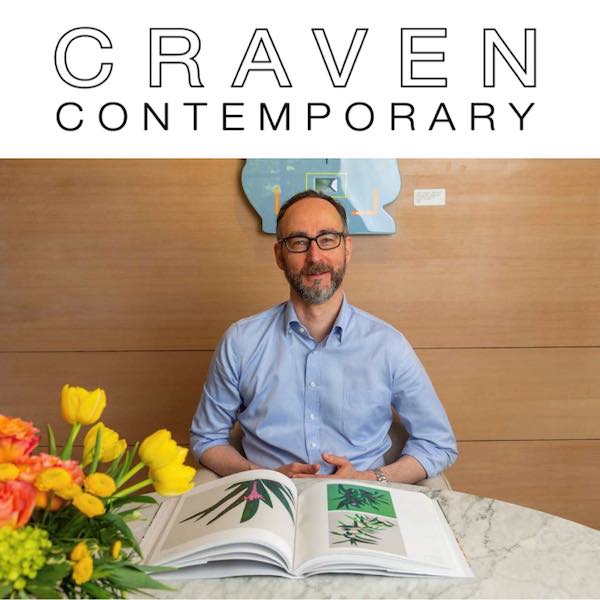The Mattatuck Museum features the work of Christian Césari, a local artist originally from Nice, who joins French modernists with his reductivist style and use of bold color.
Though Christian Césari had made drawings since he was a child, it was not until 2002 that he made his first oil painting. During the past fourteen years he has made hundreds of paintings in response to his surroundings and everyday life. To understand how remarkable Césari’s artistic trajectory is, one must know something of his life story.

Born in 1956 in Erbajolo, a village on the island of Corsica, Cesari’s youth seems to have transpired in an earlier century. He was one of three children, and his parents raised animals and farmed small patches of rocky land. The island had no electricity and no running water. The only telephone was at the post office, so neighbors would relay yells from house to house until Césari’s mother heard the man across the street shouting that she was receiving a call. There was very little commerce. The peddler who came through the village once a year leading a donkey laden with provisions like eggs, fabric, and sometimes chocolate was an exciting event. In fact, as a child, the image of a bucolic landscape painting that Cesari’s mother carefully cut from the lid of a box of chocolates she procured from the peddler and tacked to the wall was his only glimpse of the arts. In this simple, agrarian world, Césari was a shy, but curious boy.
The secondary school in the town of Corte was twenty kilometers away, too far for a family without a car. So from age eleven to seventeen, Césari boarded at the school five days a week. The conditions were harsh, and the teachers were often mean. But Césari discovered he had a facility for language, and English became his ticket to the larger world.
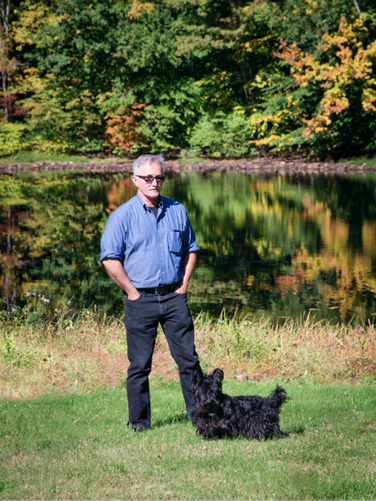
When he first arrived at the University of Nice, in France, Césari was so overwhelmed by the noise, the automobile traffic and the crowded sidewalks that for the first three months, he did not attend classes, but hid in his dorm room. Eventually, he ventured back to the university. After two years of study, he received a certificate in English.
Césari offered private English lessons until he was called for military service. Then he was hired by the Institut Français in Villefranche-sur-Mer, where first he taught English to junior high and high school aged students, but soon began to specialize in teaching wealthy foreigners to speak French. Among his more notable students were Kate Capshaw (the wife of Stephen Spielberg), Vidal Sassoon, Barbara Johnson (the Johnson & Johnson heiress), and the Queen of Norway.
Though teaching languages was fulfilling, Césari was eager to see more of the world. He took a sabbatical and taught briefly in West Virginia. After that first American sojourn, he returned to the US in 2004 to attend the Atlanta College of Art (now known as Savannah
College of Art and Design), where, at age 45 he received his Master of Fine Arts degree. As a graduate student, Césari studied art history, and gravitated to the work of Nicolas De Staël, a French mid-twentieth landscape painter who emphasized blocks of bright color to convey emotional content. Césari was also influenced by the Blaue Reiter group, the Post-Impressionist Paul Bonnard, and the California painters, Richard Diebenkorn and Wayne Thiebaud. These profoundly individualist artists share a love of color and an appreciation for the sensuality of paint. There are references to all these masters in Césari’s work, along with his devotion to high color, and his outward gaze onto the natural world.
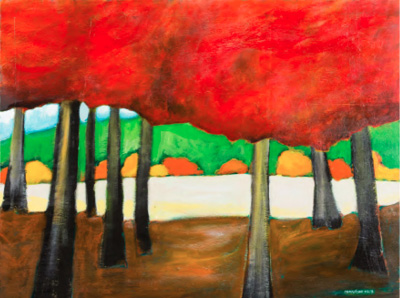
Césari does not make preparatory drawings, and he paints spontaneously through direct observation of life in and around his home in Woodbury each morning from 4:30 to 8:00. But strong compositional structure is a hallmark of Césari’s oeuvre. Often his canvas is organized as distinct areas of color and simplified shapes. The Clearing is a prime example of Césari’s reductivist style. A grove of treetops is rendered as a monolithic red form that occupies the upper third of the canvas. Between the crimson leaves and the brown foreground, the viewer peers into the sun-filled distance where orange and yellow rounded shapes accent a brilliant green hillside.
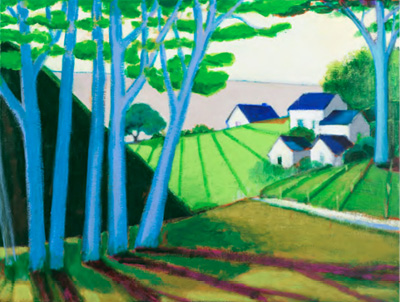
This division of the canvas into color zones is also evident in The Hamlet. Here, the space is defined as a series of intersecting triangular areas. The grove of tall trees on the left is secured by a triangle of black suggesting a deep shadow. The foreground comprises parallel shadows cast by a row of trees onto a triangular green lawn. And in the mid-ground, a third triangular area is divided by bright green fields and the smaller triangles of black roof tops. Again, the distance offers a bright light on ridge and sky.
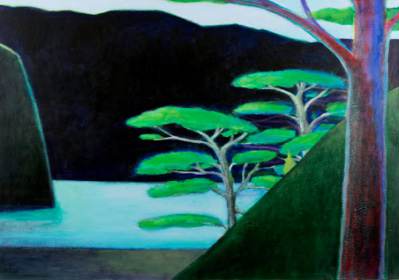
My Secret Place is uncharacteristically moody, with dark distant hills and a high horizon line. The tender green leaves and pale blue water punctuate the silhouetted hills, and the familiar triangle shape frames a pond nestled in the woods. With Saint Jean Cap Ferrat, Césari has a lighter hand. There are traces of brushwork, and a thinner application of pigment. The view from the landmark hotel near Villefranche-sur-Mer is organized on a grid, with strong horizontals defining the mountains, the sea and the foreground, and an emphatically vertical palm tree. Césari has captured the elegant locale and the famous delicate light of the South of France.
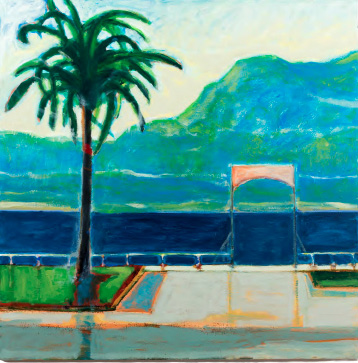
Perhaps the most abstract of Césari’s recent work is Weekeepeenee Road. The title refers to the artist’s home address in Woodbury. We see a long view of the road, a tall hedgerow as an intense mass of blue, and a lime green lawn. Two thin vertical lines help to define the space, and keep the landscape from being becoming pure color with no allusion to a particular place.
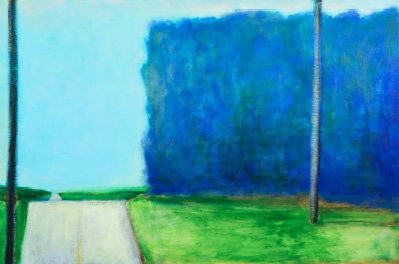
Césari offers his viewers a sunlit, optimistic world, where he clearly accentuates the positive. Perhaps this joyful embrace of the world results from the remarkable journey of his life thus far. It will be interesting to follow the evolution of Césari’s work for another fourteen years. Will he continue to navigate that crucial space between representation and expressionism, or will the lure of abstraction prevail?
Mon Grand Soleil Bleu, an exhibition of Christian Césari’s paintings, will be on view at the Mattatuck Museum in Waterbury from November 6 through December 4, 2016.
To purchase a painting or to contact Christian Césari: erbajolo@aol.com
Mon Grand Soleil Bleu: Christian Césari
November 6 to December 4, 2016
Opening Reception: Sunday, November 6, 1-3 pm
Mattatuck Museum
144 West Main Street
Waterbury
203.753.0381
www.mattmuseum.org















